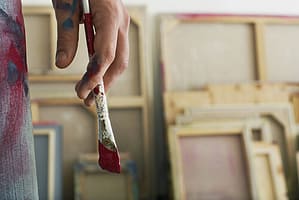
According to (15-years sober) Seattle musician John Roderick from The Long Winters, “The idea that drugs fuel creativity is nothing new. The same can be said of almost any new experience or recognition of a new reality. But like anything perception—love, adrenaline, or being a U.S. Senator—the effect dulls with time. The feeling you never thought you’d get tired of, eventually you get tired of. And, unlike love, there are only so many ways you can reinvent the experience of taking drugs—eventually it boils down to the fact that you’re just taking more drugs and stronger drugs, chasing the dragon. Drugs do fuel creativity, but being addicted to drugs, and especially dying from drugs, doesn’t.”
What is Sober Creativity?
One reason that substance users give for not getting clean is the fear of losing their creative edge. The truth is that sobriety brings a form of clarity that can deliver groundbreaking creative results. Author Stephen King is an example. Though he was concerned that sobriety would dampen his creative pursuits, he has produced some of his most successful works since overcoming addiction.
If you are feeling a loss of creativity during your recovery journey, it is more than likely due to the “brain fog” caused by post-acute withdrawal symptom (PAWS). PAWS can interfere with intellectual clarity for months, but symptoms begin to subside over time. Post-acute withdrawal symptoms include:
1. Insomnia that contributes to creative lag.
2. Difficulty concentrating.
3. Depression & lack of desire.
4. A frustrating emotional rollercoaster.
5. Short-term memory issues.
As PAWS subsides and mental clarity improves, creativity increases. When your thinking is not delusional and you decide to devote your time to healthier pursuits, there is no limit to what you can create. To make the most of creativity during addiction recovery, try:
1. Meditating. Inward focus is proven to increase mindfulness, which leads to creative success.
2. Journaling. In your journal, keep track of your recovery progress and jot notes about imaginative or inventive ideas.
3. Overcoming fear of failure. This type of fear is a creative stumbling block. Rather than fearing defeat, determine that you will not give up until you have achieved a creative goal.
4. Developing character. The most successful creatives are compassionate, humble, and open about their art. Chart a course to become the person you wish to be—without using drugs and alcohol as a crutch.
5. Finding a sober community. Many artists, engineers, and other creative professionals thrive as part of a creative group. Your therapist or addiction counselor can help you get plugged into a community of people who are working to develop their talents without relying on alcohol or drugs.
Begin Addiction Treatment at Red Oak Recovery®
If you fear losing your creative edge when you give up drugs and alcohol, our North Carolina treatment program can help. Serving young adults with all types of addictions and mental health issues, we help clients take charge of their talent—and discover new meaning for the role creativity plays in their lives. Our expressive arts instructors desire to help you reach your creative goals and expand your mind without the need for substance use, and our enrollment counselors can help you get plugged into our holistic therapy and art programs. To learn more or begin the insurance approval process, call 866.457.7426 today!








